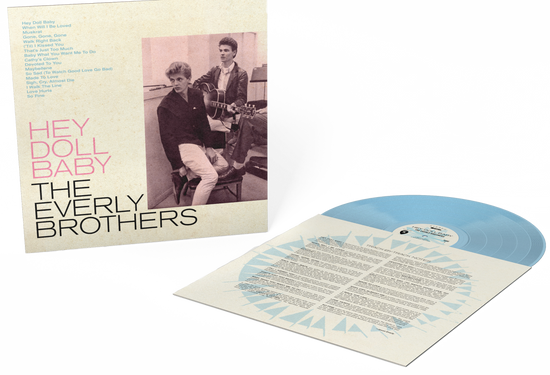Multicolumn
-
1930s
Coal Mines and Arnold Shultz
According to family legend, Ike Everly (Phil and Don’s father) and his brothers set the record for the most coal shoveled in a single day at the Muhlenberg coal mine where they all worked as young men, but when they were not at work, the family always had time to sing and play guitar. Everyone played…brothers, sisters, uncles, cousins, grandparents, you name it. And they all played well. Aunt Hattie (Ike’s sister) created something called “The Drum Piece,” which was a well-known guitar rhythm piece. When the mines closed, Ike quickly gained notoriety as a world-class thumbpicking guitar player in the unique country blues style of western Kentucky, complete with alternative tunings. The style had been passed down in the 1920s from a great unsung guitar and fiddle legend named Arnold Shultz. Shultz taught his unique style of thumbpicking to Kennedy Jones, who then passed it to Ike, Mose Rager, and then down to Merle Travis.
Ike married his pretty young neighbor, Margaret Embry in 1935. They were blessed with two sons, Isaac Donald Everly, born on February 1st, 1937 in Brownie, Kentucky, and Phillip Everly, born on January 19th, 1939 in Chicago, Illinois. As the boys grew up, they would incorporate the unique country blues style that wasn't quite country and it wasn't quite blues, but something different. From the innovative rhythmic guitar style to the traditional close family harmony singing, the quiet talent of the family was about to be heard by the world.
Read MoreCoal Mines and Arnold Shultz
According to family legend, Ike Everly (Phil and Don’s father) and his brothers set the record for the most coal shoveled in a single day at the Muhlenberg coal mine where they all worked as young men, but when they were not at work, the family always had time to sing and play guitar. Everyone played…brothers, sisters, uncles, cousins, grandparents, you name it. And they all played well. Aunt Hattie (Ike’s sister) created something called “The Drum Piece,” which was a well-known guitar rhythm piece. When the mines closed, Ike quickly gained notoriety as a world-class thumbpicking guitar player in the unique country blues style of western Kentucky, complete with alternative tunings. The style had been passed down in the 1920s from a great unsung guitar and fiddle legend named Arnold Shultz. Shultz taught his unique style of thumbpicking to Kennedy Jones, who then passed it to Ike, Mose Rager, and then down to Merle Travis.
Ike married his pretty young neighbor, Margaret Embry in 1935. They were blessed with two sons, Isaac Donald Everly, born on February 1st, 1937 in Brownie, Kentucky, and Phillip Everly, born on January 19th, 1939 in Chicago, Illinois. As the boys grew up, they would incorporate the unique country blues style that wasn't quite country and it wasn't quite blues, but something different. From the innovative rhythmic guitar style to the traditional close family harmony singing, the quiet talent of the family was about to be heard by the world.
-

-
1940s
Singing for the Farmers / Family Radio Show
In the late 1930s, the Everly family left Kentucky to move to Chicago so Ike could pursue his dream of being a musician. In Chicago, Ike played in clubs, on street corners, and had brief stint on the radio, but in the mid-1940s, Ike and Margaret decided to leave; they wanted a quieter place to raise their boys. The Everly family moved to Shenandoah, Iowa and Ike secured a job singing on KMA radio in the very early morning hours for the local farmers. Eventually, one by one the whole family joined the act. During these happy years, the family listened to music that would shape the boys' later sound, acts like the Ink Spots, The Mills Brothers, The Delmore Brothers, Lefty Frizzell, and Hank Williams.
The brothers often remarked about how cold and dark it was in the winter going to work as teenagers. All the while their school-mates had no idea they were on the local radio in the morning. But, Shenandoah was a great place to grow up and a great place to expand their musical chops. The little house where the family lived is now a museum, complete with the original fold-up bathtub.
Read MoreSinging for the Farmers / Family Radio Show
In the late 1930s, the Everly family left Kentucky to move to Chicago so Ike could pursue his dream of being a musician. In Chicago, Ike played in clubs, on street corners, and had brief stint on the radio, but in the mid-1940s, Ike and Margaret decided to leave; they wanted a quieter place to raise their boys. The Everly family moved to Shenandoah, Iowa and Ike secured a job singing on KMA radio in the very early morning hours for the local farmers. Eventually, one by one the whole family joined the act. During these happy years, the family listened to music that would shape the boys' later sound, acts like the Ink Spots, The Mills Brothers, The Delmore Brothers, Lefty Frizzell, and Hank Williams.
The brothers often remarked about how cold and dark it was in the winter going to work as teenagers. All the while their school-mates had no idea they were on the local radio in the morning. But, Shenandoah was a great place to grow up and a great place to expand their musical chops. The little house where the family lived is now a museum, complete with the original fold-up bathtub.
-
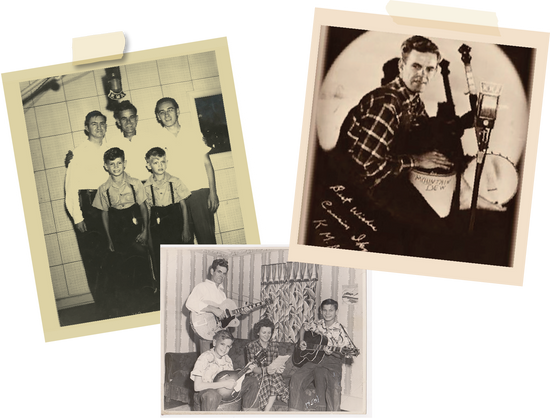
-
1950s
Knoxville - Two Years That Mattered
In 1953, after short stints at KNF Radio in Shenandoah, Iowa, and WIKY in Evansville, Indiana, Margaret pushed to move the family closer to Kentucky, and even more importantly closer to the mecca of country music…Nashville, Tennessee. They packed up their car and headed to Knoxville, Tennessee. Immediately upon their arrival, they auditioned for the “The Cas Walker Farm and Home Hour '' on WORL. Much to their surprise, they were hired immediately! Cas Walker’s show may have been an outlet to promote his grocery stores, but he also had a knack for picking fresh talent, such as a 10-year-old Dolly Parton in 1956! They were hired as the Everly Family, but very shortly it became apparent that the boys could go farther as a duo. Margaret and Ike quietly stepped aside and began cutting hair to support the boys’ dreams. It was during the Knoxville years, that the boys discovered Rock
and Roll and more specifically that Bo Diddley beat.Thou Shalt Not Steal - Chet Atkins
In 1953, Ike Everly began a correspondence with Chet Atkins. Chet was already a fan of Ike’s distinctive thumb-picking style. Ike proudly told him about his talented sons, Don and Phil. When Ike and Chet eventually met face to face in 1954, this would change everything for the brothers. Don had recently penned the song “Thou Shalt Not Steal,” and Atkins was very interested, placing it with the legendary Kitty Wells, who recorded it. The first royalty check was $600. This wa... Read More
Knoxville - Two Years That Mattered
In 1953, after short stints at KNF Radio in Shenandoah, Iowa, and WIKY in Evansville, Indiana, Margaret pushed to move the family closer to Kentucky, and even more importantly closer to the mecca of country music…Nashville, Tennessee. They packed up their car and headed to Knoxville, Tennessee. Immediately upon their arrival, they auditioned for the “The Cas Walker Farm and Home Hour '' on WORL. Much to their surprise, they were hired immediately! Cas Walker’s show may have been an outlet to promote his grocery stores, but he also had a knack for picking fresh talent, such as a 10-year-old Dolly Parton in 1956! They were hired as the Everly Family, but very shortly it became apparent that the boys could go farther as a duo. Margaret and Ike quietly stepped aside and began cutting hair to support the boys’ dreams. It was during the Knoxville years, that the boys discovered Rock
and Roll and more specifically that Bo Diddley beat.Thou Shalt Not Steal - Chet Atkins
In 1953, Ike Everly began a correspondence with Chet Atkins. Chet was already a fan of Ike’s distinctive thumb-picking style. Ike proudly told him about his talented sons, Don and Phil. When Ike and Chet eventually met face to face in 1954, this would change everything for the brothers. Don had recently penned the song “Thou Shalt Not Steal,” and Atkins was very interested, placing it with the legendary Kitty Wells, who recorded it. The first royalty check was $600. This was back when most people earned about a dollar per hour! They quickly got new tires for the family car. Don went out and bought himself some fancy brown suede shoes and pink slacks, according to Margaret Everly. The pretty boys were already stopping traffic and not just for their ducktails and long hair, although the hair was always iconic in its own right. We have to remember that these were two very fashion-forward and slightly rebellious cool young men. The world just didn’t know about them yet.
20 Minute Recording Session / Columbia Record Deal Goes Bust
The boys and Margaret headed to Nashville in 1955, upon Don’s high school graduation. After what felt like a long time (actually only a few months) of knocking on doors and busking at the backstage alley of the Grand Ole Opry, the brothers landed their first recording contract. The contract consisted of initially recording four songs. Unfortunately, the label was only going to pay for 20 minutes of recording time, in which the brothers would have to prove themselves. Phil recalled in later years, they knew that the recording session had not gone well. And sure enough, Columbia promptly dropped them!
Archie Bleyer and “Give Me a Future”In early 1957, Archie Bleyer, the owner of New York City-based Cadence records, was looking for a country act. Archie came to Nashville inquiring about talent to the head of Acuff Rose Publishing, Wesley Rose. Wesley suggested the Everly Brothers, who he had recently signed to a management and publishing deal. A short time later the brothers were signed with Cadence, and a recording session was booked at RCA’s Studio B with Chet Atkins at the helm. The first song they decided to record was a song that had been turned down by virtually every act in town. It was penned by Acuff Rose writers Boudleaux and Felice Bryant. That song was Bye Bye Love!
When Country Music Became Rock & Roll
But a funny thing happened in the studio that day. The brothers had always been seen as a country act, but they didn’t really want to play country in the traditional sense. They had their own ideas. One of the most significant, but not fully understood, was the fact that Don and Phil had been deeply impressed with the music of Bo Diddley and other acts like him. So, during the Bye Bye Love session, Don suggested adding a lick that he had created for one of his songs called “Give Me a Future” onto the front of “Bye Bye Love.” It utilized an open G tuning and an unusual rhythm. Everyone that was at the session knew immediately that this was like nothing they had heard on the front of a song before. Phil, in later years, always said that without that lick, he doesn’t know what would have happened to them. People need to remember this was in early 1957. The term “rock and roll” had not really been coined yet. Having a separate guitar intro that was not just a repeat of part of the song was totally new and groundbreaking.
The brothers had gone into the recording session on March 1st, 1957 as country artists but came out later that day as Rock & Roll pioneers. They had successfully bridged the gap between Country and Rock, and in the meantime, invented a new sound.
A Duo for the Record Books
After Bye Bye Love exploded onto the Pop charts, the Country charts, and even the R&B charts, Don and Phil faced the legitimate fear of being a one-hit-wonder. Luckily for them, Boudleaux and Felice Bryant immediately recognized the brothers’ style as singers and innovative guitar players. The next song they gave Don and Phil, “Wake Up Little Susie,” had a blank space after each stanza purposely designed for the brothers to add one of their signature guitar riffs. Don took the opportunity and ran with it, creating yet another Everly signature guitar lick for the ages. Keith Richards called Don Everly “One of the finest Rhythm Guitar Players.”
And the hits kept coming in ‘57, ‘58, ‘59, and ‘60...“All I Have To Do Is Dream,” “Bird Dog,” “Devoted to You,” “Problems,” “Til I Kissed You,” and “Let it Be Me,” just to name a few.
No one had ever seen or heard this combination of musical styles before. Groundbreaking intros and guitar riffs borrowing heavily from Rhythm and Blues. Their breathtaking and soul-wrenching Appalachian blood harmony, combined with elements of classic country music, all presented by two exceptionally handsome, ready-made teen heartthrobs. The world of music was changed forever.
Roots Part 1The brothers, always innovators, made a bold decision in 1958 to follow up their victorious chart debuts with an album called “Songs Our Daddy Taught Us.” This concept album, an homage to their father Ike, was truly ahead of its time. It was an album of traditional roots music, released at the peak of their commercial success. It was a daring move that showed their appreciation to their parents and more specifically to their father, for all he had taught them and sacrificed over the years.
-
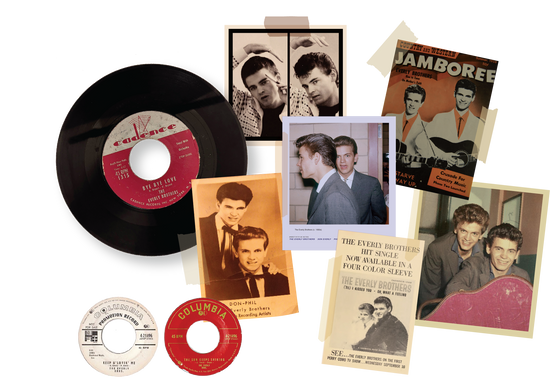
-
1960s
Warner Records Bets the Farm
Warner Records was struggling for its life in 1960. Jack Warner was ready to pull the plug on his 2 year old experiment. That’s when Jim Conkling, the label head, had a bold idea. Let’s go all-in with the Everly Brothers. Jack Warner agreed, and the Everly Brothers were offered the biggest record deal in music history up to that point. One million dollars guaranteed over 10 years. The brothers, riding high after a long string of hits with Cadence records, also agreed. They would also get screen tests with Warner Pictures. The record was designated WB1 and single-handedly saved Warner records from the trash heap. Lucky for everyone, the gamble paid off. The first single for the new label would be the biggest hit of the brothers’ career, “Cathy's Clown.” The song went straight to number 1 and stayed there for five weeks. The brothers moved to Hollywood on the heels of their new found success to try their hand at being actors. Life was good.
Acuff Rose and the Beatles
Don and Phil were riding high with their new found success out West. But, by 1961 they wanted to get out from under Acuff Rose’s onerous management and publishing contract. Wesley Rose refused to budge, so the brothers no longer had access to Boudleaux and Felice Bryant’s songs, and, even worse, Rose was making it difficult for them to record songs using their own names. Ironically, just as the brothers had kicked down the door for their version of Rock & Roll with innovative guitar licks and close ... Read More
Warner Records Bets the Farm
Warner Records was struggling for its life in 1960. Jack Warner was ready to pull the plug on his 2 year old experiment. That’s when Jim Conkling, the label head, had a bold idea. Let’s go all-in with the Everly Brothers. Jack Warner agreed, and the Everly Brothers were offered the biggest record deal in music history up to that point. One million dollars guaranteed over 10 years. The brothers, riding high after a long string of hits with Cadence records, also agreed. They would also get screen tests with Warner Pictures. The record was designated WB1 and single-handedly saved Warner records from the trash heap. Lucky for everyone, the gamble paid off. The first single for the new label would be the biggest hit of the brothers’ career, “Cathy's Clown.” The song went straight to number 1 and stayed there for five weeks. The brothers moved to Hollywood on the heels of their new found success to try their hand at being actors. Life was good.
Acuff Rose and the Beatles
Don and Phil were riding high with their new found success out West. But, by 1961 they wanted to get out from under Acuff Rose’s onerous management and publishing contract. Wesley Rose refused to budge, so the brothers no longer had access to Boudleaux and Felice Bryant’s songs, and, even worse, Rose was making it difficult for them to record songs using their own names. Ironically, just as the brothers had kicked down the door for their version of Rock & Roll with innovative guitar licks and close harmonies, other up-and-coming bands took notice and tried to emulate them. The Beatles’ Paul McCartney and John Lennon used to pretend they were the Everly Brothers, with Paul being Phil and John being Don! This is how big an influence the brothers were to the Fab Four and many, many other acts.. But as Phil said in later years, “Your audience will eventually move on to something new. Not that they still don’t love you, but people just want something new after a while. They grow up.” The brothers still enjoyed an occasional top 40 hit, but nothing like before.
Roots Part 2
The years passed with a lot of great music, if not a lot of huge success. The brothers decided to once again reach back to their country roots. In 1968, they released the album “Roots.” It was not unlike the “Songs Our Daddy Taught Us” album in its uniqueness. The “Roots” album was an eclectic mix of country music performed in their unique heartfelt style interlaced with clips of the Everly Family act from the old radio days. It is hard to keep a dry eye when listening to the innocent pre fame days of Ike, Margaret, and the boys. Today, many consider the album “Roots” gave a jump start to the early Country Rock genre. Rolling Stone magazine called it “nostalgic and contemporary at the same time.” It always came naturally for the boys to break new ground and pave paths for others to follow.
-
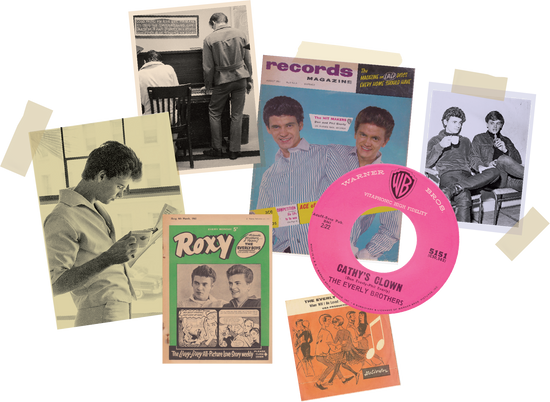
-
1970s
Time to be Apart
By 1973, Don and Phil were worn out. They had been singing side by side sharing one microphone for almost 20 years. They both had failed marriages and younger children, and it was time to take a break. Unfortunately, it happened publicly at Knott’s Berry Farm. Don was all of 36 and Phil was 34, very young men who had journeyed an awful lot of miles together. It was time to step back. Don moved back to Nashville while Phil stayed in California. Maybe they needed the miles apart to explore being their own men? One thing for certain, is they needed a break from the merry go round that their careers had become. One of the things that is often overlooked is that Don and Phil are actual brothers, so even though the public knew their split was not amicable, neither brother voiced anything negative publicly about the other. Families can love each other and still have differences. And more importantly, they were free to create their own individual identities now.
Don’s Solo Years 1973-1983
During Don’s hiatus from the Everly Brothers, he recorded three solo albums. Neither Don nor Phil had the success they had attained as a duo, but for real fans, these solo albums are a treasure trove to enjoy. You get to hear each of their voices individually and hear the kind of honest, heart-moving songs that only Don and Phil could do separately. There were many collaborations with other artists. Don recorded and toured the world with legendary guitar player Albert Lee among others. His mus... Read More
Time to be Apart
By 1973, Don and Phil were worn out. They had been singing side by side sharing one microphone for almost 20 years. They both had failed marriages and younger children, and it was time to take a break. Unfortunately, it happened publicly at Knott’s Berry Farm. Don was all of 36 and Phil was 34, very young men who had journeyed an awful lot of miles together. It was time to step back. Don moved back to Nashville while Phil stayed in California. Maybe they needed the miles apart to explore being their own men? One thing for certain, is they needed a break from the merry go round that their careers had become. One of the things that is often overlooked is that Don and Phil are actual brothers, so even though the public knew their split was not amicable, neither brother voiced anything negative publicly about the other. Families can love each other and still have differences. And more importantly, they were free to create their own individual identities now.
Don’s Solo Years 1973-1983
During Don’s hiatus from the Everly Brothers, he recorded three solo albums. Neither Don nor Phil had the success they had attained as a duo, but for real fans, these solo albums are a treasure trove to enjoy. You get to hear each of their voices individually and hear the kind of honest, heart-moving songs that only Don and Phil could do separately. There were many collaborations with other artists. Don recorded and toured the world with legendary guitar player Albert Lee among others. His music during the solo years often had a country twang. Don’s band, “The Dead Cowboys,” was a popular fixture around late-night Nashville hot spots. His 1977 country album, “Brother Jukebox,” was very well received by critics.
Phil’s Solo Years 1973-1983
Phil recorded five albums during his “time off.” He kept himself busy by making television ad movie appearances, as well as recording with Cliff Richard and many others. Though he had a regular slot at the Palomino Club (iconic country music venue) in North Hollywood, his recordings in those years leaned more towards a pop sound. Meanwhile, in 1975, Linda Ronstadt had a huge hit with “When Will I Be Loved,” a song Phil had written as a teenager. What goes around comes around, as they say. Phil was awarded the Robert J. Burton BMI Award for the most played country song of 1975. Again, for fans that really want to get to know the brothers, their solo records are a real treat.
Reunion
It was inevitable that Don and Phil would reunite one day, after all, they are brothers that are only two years apart and have a shared history only they can ever really understand. From the coal mines of Kentucky to the top of the music world. In 1983, it was time to put aside the past ten long years. A group of mutual friends arranged a meet-up for the brothers who quickly patched up their differences without missing a beat. They both agreed there was only one place to hold their reunion concert….London's Royal Albert Hall. It was the obvious choice because it held a special meaning to them. It was the last place the boys had played with their father Ike, who had passed away in 1975 during their breakup. He would have been so proud that they were coming full circle. It would be attended by the biggest names in music. Rumor has it the after party ended up at George Harrison's house, and went well into the following day! A good time was had by all who attended, as it should be.
-
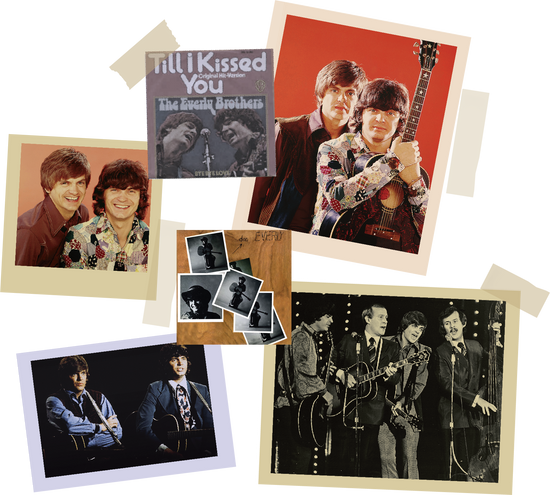
-
1980s
Rock & Roll Hall of Fame (finally)
In 1986, the Rock & Roll Hall of Fame was born. Don and Phil were inducted into the inaugural class of artists, along with Elvis Presley, Chuck Berry, Buddy Holly, Ray Charles, Jerry Lee Lewis, James Brown, Little Richard, Fats Domino, Sam Cooke, and Bo Diddley. On that night they stood tall with their peers.…the architects of Rock & Roll. The funny thing is, all of these artists were creating Rock & Roll as they played. There was no blueprint. There was no one to show them the way. They didn’t know where it would take them, but they did it anyway. Phil Everly often said that when they were doing interviews in the very early days, the second or third question he invariably got asked was “What are you going to do when this Rock & Roll thing is over?”
Read MoreRock & Roll Hall of Fame (finally)
In 1986, the Rock & Roll Hall of Fame was born. Don and Phil were inducted into the inaugural class of artists, along with Elvis Presley, Chuck Berry, Buddy Holly, Ray Charles, Jerry Lee Lewis, James Brown, Little Richard, Fats Domino, Sam Cooke, and Bo Diddley. On that night they stood tall with their peers.…the architects of Rock & Roll. The funny thing is, all of these artists were creating Rock & Roll as they played. There was no blueprint. There was no one to show them the way. They didn’t know where it would take them, but they did it anyway. Phil Everly often said that when they were doing interviews in the very early days, the second or third question he invariably got asked was “What are you going to do when this Rock & Roll thing is over?”
-

Multicolumn
-
2000s
Later Years
The Everly Brothers continued to tour together for the next 15+ years off and on until their final tour in the UK with Simon & Garfunkel in 2005. Despite many attempts to get them to perform together, on tour and on television, both Don and Phil chose to call it a career…an amazing career by any measure. The Everly Brothers finished their career with 35 top 10 songs. A record that still stands to this day. Both brothers always remarked at how lucky they had been to have lived the lives they did. Phillip Everly passed on January 3rd 2014 at the age of 74 Isaac Donald Everly passed on August 21st 2021 at the age of 84. No family is perfect, but you would be hard-pressed to find two brothers that gave more joy to the world than the Everly Brothers.
Read MoreLater Years
The Everly Brothers continued to tour together for the next 15+ years off and on until their final tour in the UK with Simon & Garfunkel in 2005. Despite many attempts to get them to perform together, on tour and on television, both Don and Phil chose to call it a career…an amazing career by any measure. The Everly Brothers finished their career with 35 top 10 songs. A record that still stands to this day. Both brothers always remarked at how lucky they had been to have lived the lives they did. Phillip Everly passed on January 3rd 2014 at the age of 74 Isaac Donald Everly passed on August 21st 2021 at the age of 84. No family is perfect, but you would be hard-pressed to find two brothers that gave more joy to the world than the Everly Brothers.
-
